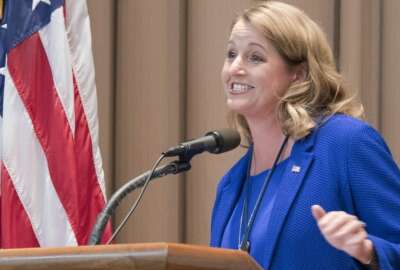
Over last 18 months, Federal CIO Kent’s goal is create a continuous improvement mindset
Federal chief information officer Suzette Kent said in an exclusive interview that during her time leading federal technology she has learned the biggest areas...
Federal chief information officer Suzette Kent has had a busy 18 months since coming to government. Her first year in as the head of federal technology has been all about cleaning up and updating policies.
Now that most of the policy updates are done—though there are several major ones that still must be finalized—Kent said all that foundational work is not only about improving federal technology today, but setting a path for the future.

“Having an approach that continuously updates, continuously improves and continuously evolves is another focus that I’ve tried to have across all the various things we are doing because we are focused right now on a point in time and we are delivering for a point in time, but many of these are foundational elements that will then empower what comes after us,” Kent said in an interview on Ask the CIO. “We have great people, the technology tools are there and as long as we continue to address the barriers, we can achieve the targets that we have. It’s really important not only for the American people and every mission that we are serving, but of the passionate people who are delivering on this mission every day that we clear the road for them to be as successful as possible and match the capabilities with the passion they have for the mission.”
In the last few months alone, the Office of Management and Budget finalized policies around shared services, identity access and credential management and federal data. OMB will release additional finalized policies around cloud computing, the Trusted Internet Connections (TIC) and data center consolidation and optimization later this summer as well.
“We have the four agencies working on what the standup of the Quality Service Management Office looks like and what that long term vision and transition looks like [for shared services],” Kent said. “We put out TIC for comment. The great thing is before the final comes out we focused on additional use cases and structure around how we ensure that we keep it current. Soon that will be coming out and you will see the nods in there and deep integration with NIST and DHS, of course, but also what ways that as technology advances or we see different tools whether it’s mobile or others, we have an ongoing way to ensure that the policy does not get old.”
Application rationalization is next frontier
The final Cloud Smart Strategy is one of the most anticipated final policies in the federal community. Many agencies and vendors alike already are using the terms and concepts outlined in the draft policy.
Kent said agencies are making real progress around basic cloud efforts for email and collaboration tools.
“We are starting to show even more progress for agency application rationalization moving them from old technology to the cloud,” she said. “We were with the HUD team [recently] talking through one of their initiatives and seeing that progress has been fantastic.”
Kent said OMB will release new data around cloud and all the IT modernization metrics in late June on Performance.gov. This data hasn’t been updated since December.
The data center policy, in many ways, underpins many of these other efforts. Kent said the application rationalization effort is so important is because it goes hand-in-hand with the data center efforts.
“By understanding what our technical environment and application environment needs are, that will help us get that last mile on the data centers both from a closure perspective as well as optimizing the ones we believe there is a reason to keep them there,” she said. “All of these things are part of our effort around reskilling on the workforce side. We will over the summer and going into the fall complete the execution of a lot of these pilot programs and then we will turn our attention on how to scale them. We want to ensure it’s not just a project we did at a point in time, but a new way of making commitments to keeping skills current in the federal workforce.”
Kent said in her 18 months on the job, she has learned that the technology journey in the government is similar to the one in the private sector.
But what is different is the processes and the people around the technology.
“That gives me a high degree of confidence that we can get to where we are going if we focus our attention on the people and the processes along with the technology change,” she said. “I have been thrilled with the talented individuals that I have met. I’ve also been frustrated by the timelines, sometimes, that it takes to get things done. I look forward to a lot of the places where some of the things I have attempted to do to bring the CIOs together to focus on what are the barriers to getting things done. I’ve put a lot of my energy and the office’s energy around those things because the intent is clear. People are incredibly passionate about the mission.”
FITARA scorecard needs to evolve
Kent said the mission-driven nature of government has helped her hone the powers of the agency CIOs.
“How do we really understand long-term transitions? That is one of the areas where there has been a really robust dialogue because the government has really operated on a project mentality versus continuous improvement,” she said. “The way that we achieve the match of the work effort and the funding is something we will continue to work on.”
And as far as empowering agency CIOs, Kent said her office is working with lawmakers and the Government Accountability Office on modernizing the Federal IT Acquisition Reform Act (FITARA) scorecard.
She said OMB continues to be supportive of the scorecard and what it’s measuring because it’s keeping agencies accountable to meeting the goals of what is important.
“What we want to do like we are talking about modernizing all of our technology is ensure the scorecard and what we measure grows with our accomplishments, but also changes based on the risk. It would be pretty easy to leave something on there where everybody made an ‘A’ but then we are not using that to signal priority or to manage risk,” Kent said. “With some of the things we are making really great progress, we can use automated tools to measure. Maybe we make that available in an automated manner more frequently and we can refocus something on FITARA.”
Copyright © 2025 Federal News Network. All rights reserved. This website is not intended for users located within the European Economic Area.
Jason Miller is executive editor of Federal News Network and directs news coverage on the people, policy and programs of the federal government.
Follow @jmillerWFED







